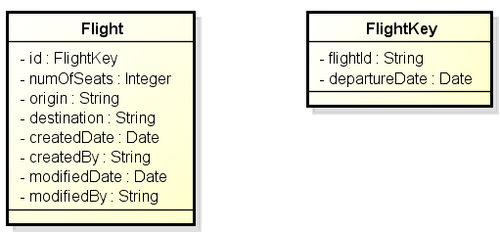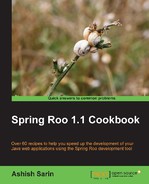In this recipe we look at how Spring Roo simplifies the creation of JPA entities using the entity and field commands. In this recipe we'll create a Flight JPA entity which has a composite primary key. Refer to the Creating a many-to-one relationship between entities recipe of Chapter 3, Advanced JPA Support in Spring Roo to see how to create persistent entities with surrogate keys.
The following figure shows the attributes of the Flight entity and its composite primary key (FlightKey):

Exit the Roo shell and delete the contents of the C:
oo-cookbookch02-recipes directory.
Execute the ch02_jpa_setup.roo script. It creates a flight-app Roo project and sets up Hibernate as the persistence provider using the persistence setup command. If you are using a different database than MySQL or your connection settings are different from what is specified in the script, then modify the script accordingly.
Start the Roo shell from the C:
oo-cookbookch02-recipes directory.
The following steps will demonstrate how to create persistent entities:
- Create a
Flightentity in thesample.roo.flightapp.domainpackage using theentitycommand:..roo> entity --class ~.domain.Flight --identifierType ~.domain.FlightKey --table FLIGHT_TBL - Add fields to the
Flightentity usingfieldcommands:..roo> field number --type java.lang.Integer --fieldName numOfSeats ..roo> field string --fieldName origin ..roo> field string --fieldName destination ..roo> field date --type java.util.Date --fieldName createdDate ..roo> field date --type java.util.Date --fieldName modifiedDate ..roo> field string --fieldName createdBy ..roo> field string --fieldName modifiedBy
- Switch focus to the
FlightKeyclass (that was auto-generated in thesample.roo.flightapp.domainpackage when we created theFlightentity in Step 1):..roo> focus --class ~.domain.FlightKey - Add
flightIdanddepartureDatefields to theFlightKeyclass:..roo> field string --fieldName flightId ..roo> field date --fieldName departureDate --type java.util.Date
The entity command is used to create a JPA persistent entity. It provides a couple of arguments which should be sufficient for most scenarios that you encounter while developing the persistence layer of your enterprise application. For instance, the mappedSuperclass argument marks the class with the @MapperSuperclass JPA annotation (refer to the Creating a mapped superclass recipe in Chapter 3, Advanced JPA Support in Spring Roo), the inheritanceType argument adds the @Inheritance JPA annotation to let you specify the inheritance strategy followed for persisting classes of an inheritance hierarchy, and so on.
The following table describes arguments that you can pass to the entity command:
You may have noticed that the field command that we have used for adding fields to the Flight JPA entity is the same field command that we had used to add attributes to our Java class in the Adding attributes to a Java class recipe in Chapter 1, Getting Started with Spring Roo.
The following code shows the Flight entity which was created by the entity command:
@RooJavaBean
@RooToString
@RooEntity(identifierType = FlightKey.class, table= "FLIGHT_TBL")
public class Flight {
private Integer numOfSeats;
private String origin;
private String destination;
...
}In the Flight.java code, the @RooJavaBean
and @RooToString annotations are the most commonly used Roo annotations. For more information on @RooJavaBean and @RooToString, please refer to the Creating a Java class and Adding attributes to a Java class recipes in Chapter 1, Getting Started with Spring Roo. The @RooEntity annotation provides details about the persistent entity which is the Flight entity in the previous code. The identifierType attribute specifies the identifier type of Flight entity, which is FlightKey—the composite primary key class of the Flight entity. The table attribute specifies the database table to which the Flight JPA entity maps.
Note
You'll notice that the fields of the entity don't use JPA @Column annotation to provide a mapping of the fields to the corresponding FLIGHT_TBL table columns. Later in this recipe we'll see how field command can be used to specify table column mapping for the fields.
The @RooEntity annotation introduces a couple of persistence related methods and attributes using the ITD file, Flight_Roo_Entity.aj, as shown here:
privileged aspect Flight_Roo_Entity {
declare @type: Flight: @Entity;
declare @type: Flight: @Table(name = "FLIGHT_TBL");
@PersistenceContext
transient EntityManager Flight.entityManager;
@EmbeddedId
private FlightKey Flight.id;
@Version
@Column(name = "version")
private Integer Flight.version;
public FlightKey Flight.getId() {
return this.id;
}
public void Flight.setId(FlightKey id) {
this.id = id;
}
public Integer Flight.getVersion() {
return this.version;
}
public void Flight.setVersion(Integer version) {
this.version = version;
}
...
}The persistence related methods (such as, persist, remove, and so on) have been omitted from the previous code listing for brevity. Auto-generated persistence related methods are discussed in the Controlling auto-generated methods of persistent entities recipe. As you can see, Spring Roo generates the necessary code to create a fully-functional JPA entity.
The following code in Flight_Roo_Entity.aj adds @Table and @Entity JPA annotations in the Flight class:
declare @type: Flight: @Entity; declare @type: Flight: @Table(name = "FLIGHT_TBL");
In Flight_Roo_Entity.aj, the FlightKey field is annotated with the @EmbeddedId annotation because it is the composite primary key class of the Flight entity. Roo also creates a version field in Flight_Roo_Entity.aj, which maps to the version column of the table to which the Flight entity maps. If we create a persistent entity that doesn't use a composite primary key, then instead of @EmbeddedId, Spring Roo uses the @Id annotation to annotate the primary key.
While generating an entity, Spring Roo also generates a <entity-name>_Roo_Configurable.aj ITD, which is responsible for adding Spring's @Configurable annotation to the entity. Here, <entity-name> is the name of the persistent entity.
The entity instances are typically created outside the Spring's application context by the JPA provider or by using the new operator. The use of @Configurable annotation is particularly useful in entities because it allows injecting beans configured in Spring's application context into the entity instance. It is because of the @Configurable annotation that Spring is able to inject the EntityManager instance into persistent entities.
The following code listing shows the FlightKey class of the flight-app application:
@RooToString
@RooIdentifier
public final class FlightKey {
private String flightId;
private Date departureDate;
}In the code, the @RooIdentifier annotation of Spring Roo is responsible for adding constructors, getter and setter methods for fields, and also provides implementation of the hashCode and equals methods of the FlightKey composite primary key class. Spring Roo generates a <entity-name>_Roo_Identifier.aj ITD file corresponding to the @RooIdentifier annotation on the composite primary key class. Here, <entity-name> is the name of the persistent entity.
The following code shows the methods and attributes defined in the FlightKey_Roo_Identifier.aj ITD file:
privileged aspect FlightKey_Roo_Identifier {
declare @type: FlightKey: @Embeddable;
public FlightKey.new(String flightId, Date departureDate) {}
private FlightKey.new() {}
public String FlightKey.getFlightId() {
return this.flightId;
}
public Date FlightKey.getDepartureDate() {
return this.departureDate;
}
public boolean FlightKey.equals(Object obj) {}
public int FlightKey.hashCode() {}
}In the code, implementation details of methods and constructors have not been shown for brevity. As the code suggests, FlightKey_Roo_Identifier.aj ITD adds the following methods, constructors, fields, and annotations to the FlightKey class:
- Adds the
@EmbeddableJPA annotation to theFlightKeyclass, which is required because theFlightKeyclass is added to theFlightentity using the@EmbeddedIdJPA annotation - Adds a no-argument constructor to the
FlightKeyclass - Adds a constructor that accepts fields defined in the
FlightKeyclass as arguments - Adds getter and setter methods for the fields defined in the
FlightKeyclass - Adds implementation for the
equalsandhashCodemethods of thejava.lang.Objectclass
The @RooIdentifier annotation accepts two attributes—gettersByDefault and settersByDefault, which allow you to control the creation of getter and setter methods for the fields defined in the FlightKey class. @RooIdentifier also accepts a third attribute, dbManaged, which is useful if the JPA entity was created by Roo using database reverse engineering. We'll discuss the dbManaged attribute in detail in the Creating entities from a database recipe of Chapter 3, Advanced JPA Support in Spring Roo.
We'll now look at how to add fields to persistent entities that contain information about the table columns to which the fields map.
Delete the origin field from the Flight.java file and ensure that Spring Roo is running in the background to remove the origin field from AspectJ ITD files.
Now, add the origin field to the Flight persistent entity using the field command, and specify the name of the table column, FLT_ORIGIN, to which the origin field maps, as the value of column argument:
~.domain.Flight roo> field string --fieldName origin --column FLT_ORIGIN
The presence of the column argument indicates that the field is annotated with the @Column JPA annotation with the value of the column argument representing the value of the name attribute of the @Column annotation, as shown here:
@RooJavaBean
@RooToString
@RooEntity(table = "FLIGHT_TBL")
public class Flight {
@Column(name = "FLT_ORIGIN")
private String origin;
}The Roo script ch02_persistent_fields.roo that accompanies this book contains commands to create the flight-app project consisting of the Flight entity and the FlightKey class. Additionally, the script adds database column mapping for all the persistent fields defined in the Flight entity and FlightKey class. It is recommended that you exit the Roo shell, remove all the files from ch02-recipes directory, and recreate the flight-app Roo project by executing the ch02_persistent_fields.roo script.
We saw in a couple of recipes that the focus command is used to switch command reference from one class or interface to another class or interface in the Roo project, followed by Roo commands that apply to that class or interface. Instead of using the focus command, you can use the class argument of the roo command (if supported by the roo command) to explicitly specify the class or interface to which the command applies. For instance, we can add a flightId field to FlightKey class without using the focus command, as shown here:
...roo> field string --class ~.domain.Flight --fieldName origin --column FLT_ORIGIN
As we can see from the field command, we can specify a fully-qualified name of the class on which the command applies.
